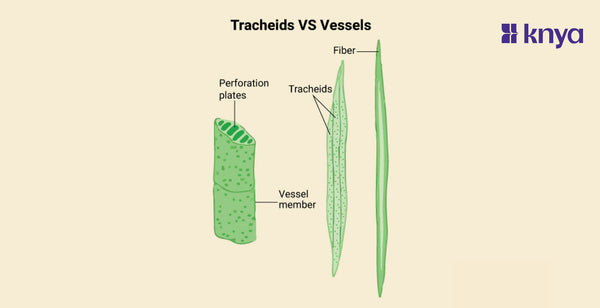Difference between Tracheids and Vessels: Plant xylem tissue contains long, dead cells called tracheids and vessels, which are in charge of moving water and minerals from roots to leaves. While vessels are exclusive to blooming plants, trayseids, which are single cells with tapering ends that overlap, are generated by the end-to-end merging of numerous cells with perforated walls, resulting in bigger and more effective water flow pipes. Although both have substantial, lignified walls for support, the vessels are the better water conductors in the plant kingdom due to their bigger diameter and unique holes.
Tracheids
- Tiny Tubes: Elongated cells with tapered ends, forming microscopic pipelines.
- Water Highway: Transport water vertically from roots to leaves for photosynthesis.
- Thick Walls: Strengthened with lignin, providing structural support for plants.
- No Living Content: Dead at maturity, focusing solely on water conduction.
Vessels
- Wider Channels: Composed of interconnected tube like cells, wider than tracheids.
- Faster Flow: Facilitate rapid water transport across long distances in plants.
- Thinner Walls: Lack lignin compared to tracheids, allowing for efficient water movement.
- Short-Lived: Individual cells die over time, but new ones form to maintain the flow.
Difference between Tracheids and Vessels
The xylem tissue of vascular plants has two different cell types called tracheids and vessels, which are in charge of moving minerals and water from the roots to the rest of the plant. The aforementioned differences between vessels and tracheids
|
Feature |
Tracheids |
Vessels |
|
Cell Structure |
Elongated, tapering with pointed ends |
Shorter, wider with open ends |
|
End Walls |
Closed, tapering with pits |
Open, often perforated |
|
Cell Connection |
Connected end to end in a series |
Connected end to end, forming tubes |
|
Cell Diameter |
Smaller |
Larger, allowing more efficiency |
|
Pits |
Relatively simple, tapered openings |
Larger and may be more complex |
|
Cell Wall Thickness |
Thick |
Thinner |
|
Length |
Longer |
Shorter |
|
Water Transport Efficiency |
Less efficient |
More efficient due to wider lumens |
|
Distribution |
Found in gymnosperms and angiosperms |
Mostly found in angiosperms |
|
Presence of Sieve Plates |
Lack sieve plates |
May have sieve plates |
Browse Best Scrubs Collection
What are Tracheids?
These are lengthy, dead cells that are present in every vascular plant's xylem. They move water and nutrients from the roots to the leaves like tiny pipelines. Because they don't have the specific holes that vessels do, water moves a little more slowly through them. Nonetheless, they aid in providing structural support and are essential for the movement of water, particularly in plants without vessels.
Key Features of Tracheids:
- Tracheids are long and slender, resembling thin tubes. Their tapered ends allow them to overlap and connect end-to-end, forming continuous water-conducting channels.
- Their cell walls are reinforced with lignin, providing strength and rigidity. However, these walls aren't completely solid. They have tiny pores called pits, which allow water to pass between adjacent tracheids.
- Unlike most plant cells, mature tracheids lack cytoplasm and a nucleus. This reduces energy expenditure and allows for efficient water transport.
- Tracheids are present in all vascular plants, from ancient cycads to modern flowering trees. They often play a primary role in water transport in conifers and other gymnosperms.
What are Vessels?
Only seen in angiosperms, or blooming plants, vessels are like superhighways for water! They are made up of linked dead cells that have holes in their walls at the ends, allowing water to flow through them continuously and widely. One important adaptation that sets blooming plants apart from their cousins is the quick and effective movement of water made possible by their distinctive form.
Key Features of Vessels:
- Vessels are formed by the end-to-end fusion of multiple elongated cells called vessel elements. These elements lack their own end walls, creating a continuous, uninterrupted tube for water flow.
- Vessel element walls are thinner than those of tracheids and have larger pits called perforations. These perforations allow for rapid and efficient water movement between elements.
- Individual vessel elements are relatively short-lived and often become non-functional over time. They rely on adjacent living cells for support and protection.
- Vessels are a defining feature of flowering plants (angiosperms). They contribute to the rapid water transport needed to support their diverse and complex structures.
Shop Best Lab Coats from Here!
Similarities between Tracheids and Vessels
- Function: Both tracheids and vessels function in water and mineral transport within the plant.
- Xylem Composition: Both are components of the xylem tissue in vascular plants.
- Cellulose Composition: Both tracheids and vessels have cell walls composed mainly of cellulose.
- Dead Cells: Both cells are typically dead at maturity, contributing to their function as conduits for water.
- Lignin Deposition: Both tracheids and vessels may undergo lignification to strengthen their cell walls.
- Pit Function: Pits in both cell types allow for lateral movement of water between adjacent cells.
- Contribution to Plant Support: Both cell types contribute to the structural support of the plant by forming part of the xylem tissue.
Transporting water from roots to leaves is facilitated by tracheids and vessels, which are essential parts of the xylem tissue of plants. But their functions are defined by important distinctions. All vascular plants have crypts, which are small cells with continuous cell walls; angiosperms only have vessels, which are broader tubes made of long cells stacked one on top of the other with walls punctured. The efficiency of this design difference is that water moves through the wider, unbroken vessels more quickly than it does through the smaller, pit-connected tracheids. Furthermore, because of their tapered ends, tracheids greatly aid in structural stability, while vessels are primarily concerned with water conduction. Essentially, these unique xylem components offer an intriguing examination of divergent adaptations for ideal water transfer and plant robustness, even if their functions are similar.
| Check out More Articles | |
| Difference Between Psychosis and Neurosis | |
| Dorsal Vs Ventral | |
| Difference Between Striated and Unstriated Muscles | |















